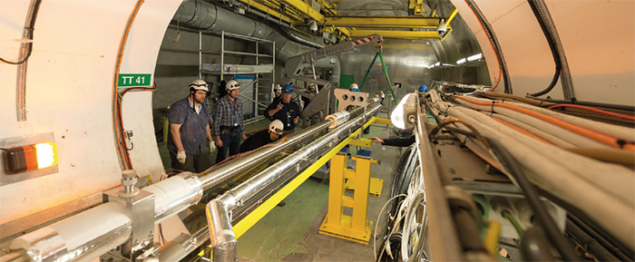
Image credit: CERN.
By harnessing the power of wakefields generated by a proton beam in a plasma cell, the AWAKE experiment at CERN (CERN Courier November 2013 p17) aims to produce accelerator gradients that are hundreds of times higher than those achieved in current machines.
The experiment is being installed in the tunnel that was previously used by the CERN Neutrinos to Gran Sasso facility. In AWAKE, a beam of 400 GeV protons from the CERN Super Protron Synchrotron will travel through a plasma cell and will generate a wakefield that, in turn, will accelerate an externally injected electron beam. A laser will ionise the gas in the cell to become a plasma and seed the self-modulation instability that will trigger the wakefield. The project aims to prove that the plasma wakefield can be driven with protons and that its acceleration will be extremely powerful – hundreds of times more powerful than that achieved today – and eventually to provide a design for a plasma-based linear collider.
The AWAKE tunnel is progressively being filled with its vital components. In its final configuration, the facility will feature a clean room for the laser, a dedicated area for the electron source and two new tunnels for two new beamlines: one small tunnel to hold the laser beam, which ionises the plasma and seeds the wakefields, and a second, larger tunnel that will be home to the electron beamline – the “witness beam” accelerated by the plasma. At the beginning of February, the plasma cell was lowered into the tunnel and moved to its position at the end of the proton line. The cell is a 10 m-long component developed by the Max Planck Institute for Physics in Munich (Germany). A first prototype successfully completed commissioning tests in CERN’s North Area in the autumn of 2015. The prototype allowed the AWAKE collaboration to validate the uniformity of the plasma temperature in the cell.
AWAKE is a collaborative endeavour with institutes and organisations participating around the world. The synchronised proton, electron and laser beams provided by CERN are an integral part of the experiment. After installation of the plasma cell, the next step will be installation of the laser, the vacuum equipment and the diagnostic system for both laser and proton beams.
Beam commissioning for the proton beamline is scheduled to start this summer. The programme will continue with installation of the electron line, with the aim of starting acceleration tests at the end of 2017.








